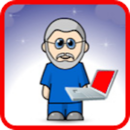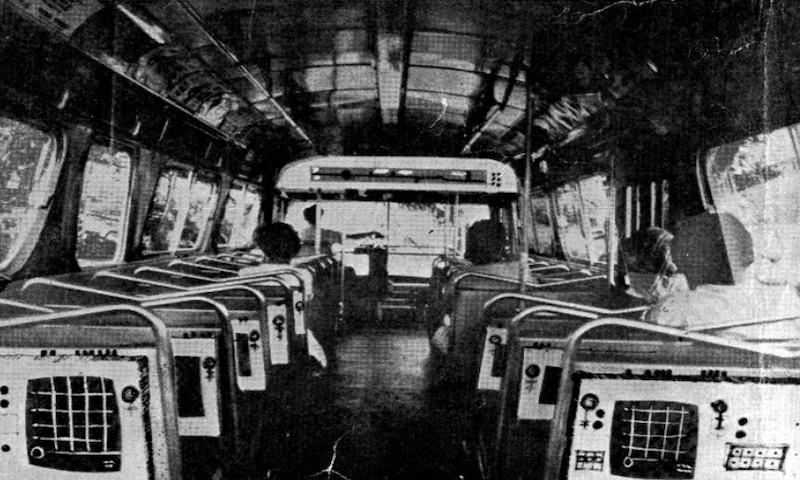ATOM: A generating system designed by Cedric Price
• Screenshot: 'Facsimiles anticipating beneficial social change'
- "While many of the articles in (the May 1968 issue of AD) refer to schools and school rooms, the common theme is that the buildings and fittings normally associated with the provision of educational facilities are not good enough, and that it is no longer a question of improvement but of re-think."
- (Cedric Price, AD 5/68)
[edit] Introduction
Design of Atom started in June 1967. It was first published as:—
- 'Total Learning Environment with a Kit of Parts', in 'Progressive Architecture (April 1968), pp.208-210;
- 'Atom: Design for New Learning for a New Town', in Architectural Design (May 1968), pp.232-235;
- 'Education in the New Town', in Cannady, W. (1970) 'New Schools For New Towns', pp.24-33.
However, since these early publications, there has been relatively little published about Atom - see References.
Now, over fifty years later, it is hoped that architects might find it 'interesting' and 'important'. This is primarily because Atom was, to borrow from Cedric Price:—
- "...singular, if not unique, in recognising, in architectural terms, the necessity for anticipation of social change in community and the individual, and in the constructive response of the built environment."
- (Cedric Price, 1999)
The project, including 37 digitized items, is filed away in the Cedric Price fonds at the Canadian Centre for Architecture. [1]
Thus the purpose of this article is to bring Atom out of the archive and make it more accessible.
[edit] ATOM
- "The educational plan used as a basis for the design was drawn up by J. E. Tirrell and A. A. Canfield and was similar to that outlined in their article, Goodbye to the Classroom on page 223, AD/5/68." [2]
- (Cedric Price, AD 5/68)

|

|
• 'Facsimiles of ATOM spreads designed by Cedric Price'
nb The project was originally entitled "Atomia - New education for a new town". [3]
- "The introduction of a new. largely invisible network related to communication, information and learning has enabled a social structuring of an otherwise directionless suburb. New physical forms tend to overlay the existing rather than replace them whilst the previously run down area 'across the tracks' towards the industrial zone is likely to become the new linear forum for opportunity and enterprise." [4]
- (Cedric Price, 1984)
[edit] Thesis
|
(Cedric Price, AD 5/68) |
 • Facsimile: 'Diagrammatic plan of new town with typical links...' designed by Cedric Price
• Facsimile: 'Diagrammatic plan of new town with typical links...' designed by Cedric Price
- Diagrams like this one from the Atom spread indicate what Cedric Price described as:—
- "...distribution throughout the town of individual, group, community, social, commercial and industrial electronic audio-visual exchange points with major industrial zone on left." [4]

|
[edit] Components |
[edit] Elements |
[edit] Town Brain"The exact nature of this 'Town Brain' is not spelled out: it might be a computer, it might be a city management organisation incorporating various control mechanisms. Though one thing is for certain, it would house a databank of the life of the community." (Arata Isozaki, 2003) [6] |
|
[edit] Industrial/Educational Show-case
|
|
[edit] Commercial/Educational Show-case |
|
[edit] Auto Link |
|
[edit] Rapid Transit Servicing |
|
[edit] Home Study Station |
|
[edit] Infant Teach Toy |
|
[edit] Open Air Servicing |
|
[edit] Life Conditioner Box• 3D Warehouse [7] |
|
[edit] Life Conditioner Tent |
|
• Table 1: 'Components and elements listed in AD 5/68'
Thus Cedric Price's thesis affirms its first premise - i.e. "a first set of tools (buildings, equipment, etc.)".
However, the early publications noted above also provide evidence to support another proposition, namely:—
- ... that Atom is a system comprised of 'components' each of which is comprised of 'elements'.
[edit] Textual records
In addition to the content of the early publications the Cedric Price fonds contains the following textual records:—

|

|

|

|

|

|

|

|

|

|

|

|

|

|

|

|
• Table 2: 'Textual records from the Atom file at the CCA'
However, the findings of this article indicate:—
- ... that the content of the early publications and the textual records in the Atom file at the CCA does not in itself provide sufficient evidence to affirm the second premise - i.e. "a development plan sufficiently indeterminate to encourage varied and possible diverse development modes."
[edit] Development modes
Instances of varied and possible diverse development modes include:—
- Detroit Think Grid [8]
- Birmingham Midland Institute [9]
- Cambridge-Milton Keynes Think-Links [10]
- Oxbridge Community College [11]

|

|

|

|
• Table 3: 'Mockup layouts for articles featuring diverse development modes'
For example:—
- Detroit Think Grid was designed by Cedric Price in 1968, at the invitation of John Tirrell and Cranbrook Academy, with the aim of making the education "system" flexible and responsive to the needs of the community and readily accessible to everyone.
- Birmingham Midland Institute was a proposal by Cedric Price in 1970 for a municipal and regional "nerve centre".
- Cambridge-Milton Keynes Think-Links is an unpublished work "in progress" by Norman Fellows in response to a proposal by Cedric Price - i.e. "Cambridge-Milton Keynes loose links may well provide additional fragmented educational servicing web (cf. Atom, AD 5/69)".
- Oxbridge Community College is another unpublished work "in progress" by Norman Fellows. [12]
Thus this article finds that such development modes affirm the second premise - i.e. Atom's development plan is sufficiently indeterminate to encourage varied and possible diverse development modes.
Furthermore, in 1968, at the same time as the earliest publications of Atom, Christopher Alexander published an article which introduced ways in which systems thinking could be most directly applied to built environments. [13]
- "A generating system is not a view of a single thing. It is a kit of parts, with rules about the way these parts may be combined."
- Alexander, 1968
Thus the diverse development modes evidenced above support another proposition, namely:—
- ... that Atom is a generating system designed by Cedric Price.
More recently, in 2015, Kathy Velikov published an article about Cedric Price's Detroit Think Grid which also includes a critique of the Atom project. It notes:—
- "Price's project, which he referred to simply as Atom in publications, conceived of a networked learning infrastructure comprised of a decentralized "kit of educational parts" incorporated within existing urban spaces and infrastructures."
- Velikov, 2015 [14]
[edit] Conclusion
This article affirms both premises of Cedric Price's thesis, namely:—
- ... that a first set of tools (buildings, equipment, etc.) is a necessity;
- ... that the indeterminacy of a development plan such as the one for Atom can be sufficient to encourage varied and possible diverse development modes.
Thus Cedric Price's thesis achieves its object, namely:—
- "to suggest methods whereby 'town' planning and individual, artefactual conditions can be so designed as to encourage an increased exploitation by society of the range of choice available at any one time."
In addition, this article concludes, firstly:—
- ... that Atom is a system generated by a decentralized kit of educational parts - i.e. 'components' each of which are comprised of 'elements'.
- ... that Atom is itself a generating system.
and, lastly:—
- ... that Atom occupies a low level in a hierarchical system;
- ... that there is a high level in this system.
Thus work "in progress" by Norman Fellows relates Atom to the highest level - i.e. a world educational system - namely:—
- 'Edukit'.
[edit] Notes
[1] Canadian Centre for Architecture (2008) 'Project: Atom, 1967-1968', AP144.S2.D71, Cedric Price fonds.
[2] Tirrell, J.E. and Canfield, A.A. (1968) 'Goodbye to the Classroom', Architectural Design, May.
[3] Price, C. (1967) 'Atomia - New education for a new town (draft)', CCA.
[4] Price, C. (1984) 'Cedric Price: Works II', Architectural Association.
[5] Price, C. (1967) 'Thesis (draft)', CCA.
[6] Isozaki, I. (2003) 'Erasing Architecture into the System', in 'Re:CP' by Cedric Price.
[7] Fellows, N. (2017) 'Life Conditioner Box', 3D Warehouse.
[8] Price, C. (1971) 'Detroit Think Grid' in 'Cedric Price Supplement No.3', Architectural Design, June.
[9] Price, C. (1971) 'Birmingham Midland Institute' in 'Cedric Price Supplement No.3', Architectural Design, June.
[10] Fellows, N. (2021) 'Cambridge-Milton Keynes Think-Links', Unpublished.
[11] Fellows, N. (2021) 'Oxbridge Community College', Unpublished.
[12] Price, C. (1967) “A Proposal to Develop THINK-LINKS between the College, the Ghetto and the Outer Community,” CCA.
[13] Alexander, C. (1968) “Systems Generating Systems”, Architectural Design, December, pp. 605-610, in Patterns' Digital Library.
[14] Velikov, K. (2015) 'Tuning Up the City - Cedric Price's Detroit Think Grid', ResearchGate.
[edit] References
Cannady, W. (1970) 'New Schools For New Towns', Rice University, pp.24-33 - also available as a PDF.
Isozaki, I. (2003) 'Erasing Architecture into the System', in 'Re:CP' by Cedric Price.
Price, C. (1968) 'Total Learning Environment with a Kit of Parts', Progressive Architecture, April, pp.208-210.
Price, C. (1968) 'Atom: Design for New Learning for a New Town', Architectural Design, May, pp.232-235.
Tirrell, J.E. and Canfield, A.A. (1968) 'Goodbye to the Classroom', Architectural Design, May.
Velikov, K. (2015) 'Tuning Up the City - Cedric Price's Detroit Think Grid', ResearchGate.
[edit] Further Reading
Canadian Centre for Architecture (2008) 'Atom', Cedric Price fonds.
Price, C. (1967) 'Atomia - New Education for a New Town', CCA.
Signature--Archiblog 16:55, 10 May 2023 (BST)
[edit] Related articles on Designing Buildings
EDUKIT: World Educational System
Featured articles and news
Gregor Harvie argues that AI is state-sanctioned theft of IP.
Many resources for visitors aswell as new features for members.
Using technology to empower communities
The Community data platform; capturing the DNA of a place and fostering participation, for better design.
Heat pump and wind turbine sound calculations for PDRs
MCS publish updated sound calculation standards for permitted development installations.
Homes England creates largest housing-led site in the North
Successful, 34 hectare land acquisition with the residential allocation now completed.
Scottish apprenticeship training proposals
General support although better accountability and transparency is sought.
The history of building regulations
A story of belated action in response to crisis.
Moisture, fire safety and emerging trends in living walls
How wet is your wall?
Current policy explained and newly published consultation by the UK and Welsh Governments.
British architecture 1919–39. Book review.
Conservation of listed prefabs in Moseley.
Energy industry calls for urgent reform.
Heritage staff wellbeing at work survey.
A five minute introduction.
50th Golden anniversary ECA Edmundson apprentice award
Showcasing the very best electrotechnical and engineering services for half a century.
Welsh government consults on HRBs and reg changes
Seeking feedback on a new regulatory regime and a broad range of issues.
CIOB Client Guide (2nd edition) March 2025
Free download covering statutory dutyholder roles under the Building Safety Act and much more.




































